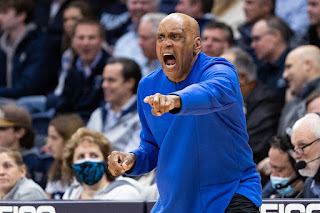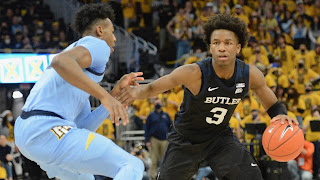Georgetown Hoyas
Head Coach: Patrick Ewing (68-84)
Three-Year NET Average: 110.3
Three-Year kenpom Average: 101.7
Projected 2022-23 T-Rank: 177
Projected Starters: PG Primo Spears (6'3" Jr), SG Jay Heath (6'3" Sr), SF Brandon Murray (6'5" So), PF Akok Akok (6'9" Sr), C Qudus Wahab (6'11" Sr)
Photo by Frank Franklin II | AP Photo
After a disappointing 2020-21 regular season, there was optimism in D.C. after a Big East Tourney title and NCAA bid. They had Dante Harris back after his BET MVP award, the highest-ranked recruit in the Big East in Aminu Mohammed, and viable three-point threats in Donald Carey and Kaiden Rice. That optimism carried Hoyas fans right up to the opening night, when they lost a buy game to Dartmouth. They did manage to beat rivals Syracuse, but finished non-con a mediocre 6-5. But like the Big East Tournament, conference play is a chance to rejuvenate the season, right? Wrong, in the Hoyas' case. They went 0-19 in the Big East, setting a conference record for regular season losses. They also lost their opener in the conference tournament, becoming the first team since 1994 Miami to go completely winless against conference opponents (even 2009 DePaul won a game at MSG).
In response, Patrick Ewing fired two of his assistant coaches and relegated Louis Orr to a developmental role, opening the way for three new assistants. That staff also brought in five new transfers to start the season. At a glance, Primo Spears fits in perfectly, in that he's a high-usage, low efficiency guard whose previous team lost seventeen straight games against conference foes to end the season. Jay Heath is a more reliable shooter who spent time at Arizona State and Boston College, but like Spears has never played for a program that finished the season with a record above .500. Brandon Murray is the prized recruit, and the reason Patrick Ewing brought in Kevin Nickelberry from LSU. Murray started for the Tigers, averaging 10.0 ppg for a tourney team last year. Akok Akok is a long, athletic forward that brings a defensive edge and ability to stretch the floor. Qudus Wahab is a boomerang transfer, having left Georgetown for Maryland a year ago only to return after Kevin Willard took over. Wahab was effective as a rim protector and rebounder for Ewing but didn't have as big a role as he might have liked with the Terrapins. Harris is also back, though expected to come off the bench after being a disappointment last year. They also have a mix of experienced transfers in Bryson Mozone and Wayne Bristol as well as freshmen in Denver Anglin and D'Ante Bass that are expected to contribute.
The hope for the Hoyas will be getting back to what Ewing wants to do. They like to run four-out around a big, with Wahab having succeeded in that role before and the other four all capable of knocking down outside shots. Last year they had Aminu Mohammed to slash to the rim, but none of their current guards are nearly as good at attacking through contact. Wahab will stay down low, expected to clean the glass. Offensive rebounding is the one thing Ewing's teams have consistently done well and Wahab, Akok, and reserve center Ryan Mutombo should all keep that up. On defense, it's all funneling teams to the middle and having the shot-blocker shut down the opposing attackers. As a consequence, they don't deny passing lanes, create turnovers, or pay much attention to the three-point arc, which has led to four of five seasons outside the top-100, punctuated by a Ewing-worst #228 last year. Generally, Ewing's teams don't seem to care much about defending. If they are going to turn things around, that has to change, but it's hard to envision an entirely new starting lineup finding much cohesion, especially early on.
Let's be frank, if literally anyone on earth not named Patrick Ewing had one winning season in five years and had a winless Big East season at Georgetown, they would be cashing their buyout check. The only reason Ewing is still here is because his name means so much to the University. While there is some excitement around their transfer haul, it's important to put it in context. Wahab had success individually with Ewing, but that team was 9-12, 7-9 in the Big East before their miracle BET run and subsequent implosion in the NCAA Tournament. Akok Akok was a fine role-player for UConn, but injuries limited him to double-digit minutes in just 6 of 36 contests for the Huskies over the past two years, with 26 DNPs in 56 games. Murray had a nice freshman campaign, but he wasn't nearly the player Mohammed was last year, which is why he transferred to Georgetown instead of going to the NBA. And both Spears and Heath come from programs that haven't won. On top of it all, four of the top-five scorers from last year are gone and the one that returned is headed to the bench. It's hard to sell that this team will lose the bulk of their best players and get better on the premise that these players just aren't quite as bad as the old ones were, especially when the guy running things hasn't changed. It's hard to fire a legend, but if Ewing couldn't make a tournament with James Akinjo, Mac McClung, Jessie Govan, Josh LeBlanc, and Jamorko Pickett, why would anyone trust him to do it with this cobbled together roster of role-players and losers, at least in terms of record? If they make it to tenth in the Big East, it should be considered a massive accomplishment, but still shouldn't be enough to save the job of the worst coach in the league.
Marquette Memory: While Patrick Ewing has been poor at Georgetown, one thing he's been good at is finding ways to derail Marquette fan hopes. It started in 2019. After opening Big East play 12-2 and needing just one win to secure a Big East title, Marquette gave up a 5-point lead at Villanova with 5 minutes to play, a 4-point lead against Creighton with 5 minutes to play, and a 9-point lead at Seton Hall with 5 minutes to play. Despite all that, Nova lost at Seton Hall on the final day of the season, putting Marquette in position to share the Big East title with a home win against Georgetown. The teams traded blows in the first half, but after an 11-0 run put Marquette up 8, it looked like the title was coming to Milwaukee. But the Hoyas chipped away, taking back the lead with seven minutes to play and holding on for an 86-84 victory.

















